“I can say hand over heart I’d live nowhere else and I think I’d do nothing else either. I’m very happy with what I’m doing.”
That’s the perspective of Co Kerry suckler farmer Conn O’Shea. Farming in the south-west corner of Valentia Island, his farm is just across the water from Portmagee and looks out on the Skellig islands. From there, he runs a spring-calving suckler-to-store system.
“We’re calving from the first of February until the first week of April. Bulls are normally sold in January and February as yearlings and heifers are generally sold at 18 months, but this year we went away from that in an effort to cut back on manure. They were sold out of the shed in March and April. So at the moment, we’ve just 10 bulling heifers, 70 cows 70 calves.”
Similar to most suckler cows in south Kerry, there’s a strong continental base. This is helped in part by a breeding scheme devised by Iveragh Co-operative mart over 20 years ago that enabled farmers take a low interest loan to buy a top-quality bull and pay it back when they were selling their weanlings.
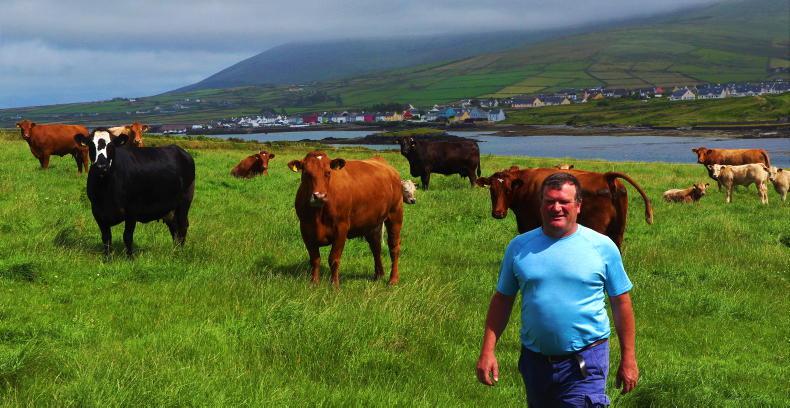
Conn O'Shea farms on the southern shore of Valentia Island. Portmagee is visible in the background.
By his own admission, Conn’s cows are a mix of breeds. “The majority would have a bit of Limousin in them, a few Charolais, a few Belgian Blues. In recent years, there’s been daughters from the Angus bull ZLL too. None would have more than three-quarters of any breed.”
Breeding wrapped up at the start of July and most years it consists of a combination of AI and stock bulls.
“I’ve been using AI for six weeks with the pick of the cows to try and get good replacements. After that, I’d leave the bull off with them. This year I was busy with other stuff, so the bulls were let off earlier. We had three groups of cows this year, so we had Charolais bulls with the cows and a high replacement index Limousin for the heifers and some of the cows.”
Similar to many suckler farmers, Conn’s land base is fragmented. There are five separate blocks plus commonage rights on Bray head at the western end of the island. Ranging in size from 20ac to 40ac, there are three miles between the furthest holdings. The block furthest away is primarily for silage and in early August, Conn buys lambs that are put on that ground and tries to finish them before Christmas. Included in the rented land is a parcel of ground on the mainland.
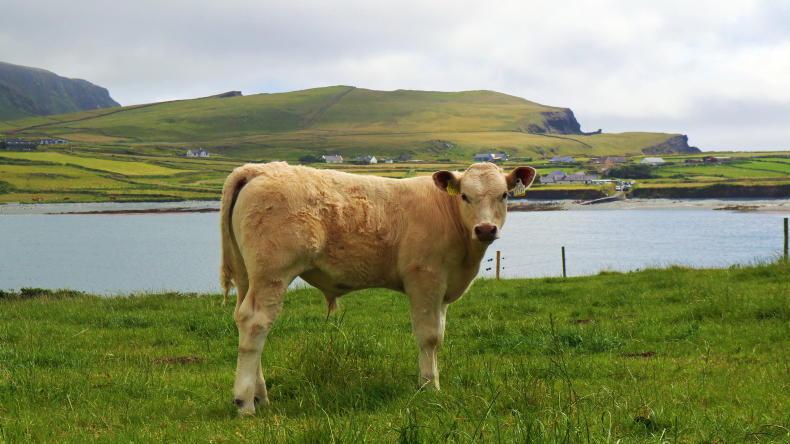
A Charolais calf on the farm of Conn O'Shea, Valentia Island.
That might sound a bit more dramatic than it actually is. A bridge linking the island to nearby Portmagee was opened just over 50 years ago, making day-to-day life on the island a bit easier. That piece of rented ground also happens to be across the water from the O’Shea homestead and stock are clearly visible from there. Once those cattle are seen up and about every morning, Conn can focus on getting other work completed before physically checking them.
“There’s a shed there too, so at the beginning of the winter, I put some cows over there. There’s no hassle with them, whereas you’d rather keep the weanlings here because they need a bit of looking after. I swap them around after Christmas when the weanlings are toughened up and I calve everything at home.”
Regarding the future, Conn is hopeful there is a place for the suckler cow but is aware of the challenges.
“There’s a vibrant farming community down here, but I’m sure it’s the same as everywhere else, it’s aging. The suckler cow is a massive part of the economy in south Kerry and up along the western seaboard. There’s a fierce spend off her and everything is put back in the local economy.
The suckler cow is a massive part of the economy in south Kerry and up along the western seaboard
“Suckler farming provides a great lifestyle to raise a family too. I farm in partnership with my wife Brigid, who’s a civil servant, and we have three girls, Aisling 21, Caoimhe 20, Ruth 18 and a boy, Rian. He is 15 and has a good interest in farming. He renovated a David Brown 995 and sold it on and his latest project is a John Deere.”
To overcome the challenges farming a fragmented holding can pose, Conn has developed a system that suits his farm and his own time.
“It’s simple, we won’t complicate it. I depend on my family for help and they’re all busy doing other jobs, so I have to have it set up as best I can.”
One example of this is prioritising getting cows and calves out to grass in small groups over the different land blocks in spring.
That organisation is visible throughout from the yard out to the fields. Roadways lead to the land adjacent to the yard and paddocks make herding straightforward. To further streamline the workload, cows are given a small bit of ration any time they come into the yard. That incentive reduces stress on man and beast and makes the stock easier to work with. Cows and calves are split up whenever there is crush work to be done.
“No matter what, we bring them in before we try and split them. You probably have about a minute to do it while the cows are eating, but it makes them easier to handle them on their own and you’re trying to train the calves too,” Conn says.
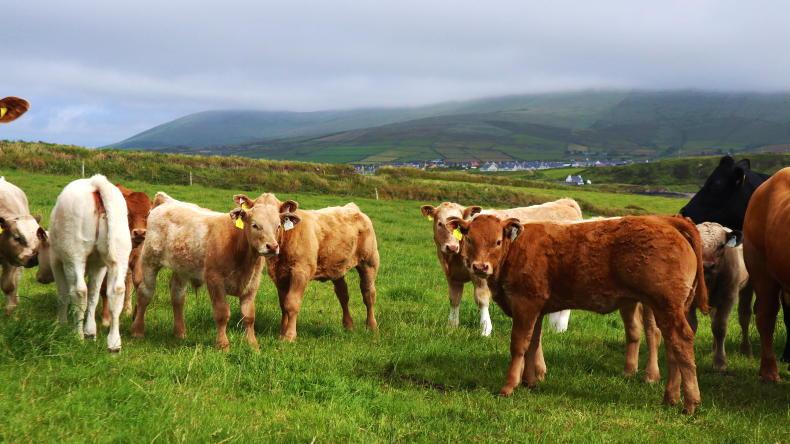
Conn uses some AI but also runs Charolais and Limousin stock bulls.
As well as farming, tourism is another sector synonymous with Kerry and Conn, like many others, has a foot in both camps. Every summer, he takes tourists out on a boat to the Skellig Islands.
“I’m set up for it and I enjoy getting out there and meeting people. The boat work fits in well with the farm. At this stage of the year, breeding is over as the bulls were removed from the cows at the start of July and the bulk of the silage is in. I work with Skellig Coast Adventures and only 15 boats can land on the islands per day, so for July and August, the boats are booked out. I can either do a morning or evening trip, so it works perfect for this time of year.
“COVID-19 interrupted things a bit, but there were a good few Irish tourists around those two years. This year, there’s more yanks and foreign tourists about again.”
Conveying tourists on the ocean isn’t Conn’s only involvement with the sea. He has been a volunteer with the RNLI lifeboat in Valentia for 30 years. When the call comes in, Conn has to down tools and head to sea.
“It has happened, down through the years. You’re in the middle of a farm job or a calving and the pager goes and you go. You’d depend greatly on neighbours when that happens. They mightn’t jump in if I’m taking people to the Skelligs or making money, but the lifeboat is different.
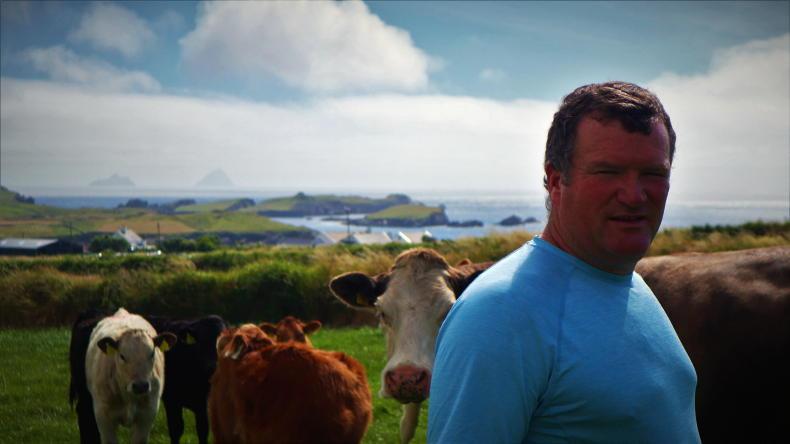
A field with a view: Conn O’Shea with his suckler cows looking out on the Skelling Islands.
“The Valentia Lifeboat is everybody’s lifeboat. We cover a good bit of sea, the range of the boat is about 250 miles. We cover down to Dursey Island off Cork and up as far as the Blaskets and all the way out to America.”
The America bit was said in jest, but as farms in the Way Out West series go, you’re unlikely to find one further west than Conn’s. A short walk away from the yard is where the first transatlantic cable between Europe and Newfoundland came ashore in July 1866.
Farming on the periphery of Ireland and Europe has its challenges. Distance from most places would be chief among them and with it access to markets. But technology has played a part in improving the situation.
“We haven’t gone down the road with finishing cattle really. There’s no factory within over two hours of here. The only place I would have had cattle killed is in Bandon and that’s mainly been a few cull cows or bull. We’d sell everything in Caherciveen mart. We’d hate to be trying to manage down here without our mart.
“It has a great reputation and the online selling has been a big help because we’re so far from anywhere else that buyers wouldn’t be as inclined to travel, but online has changed that. The mart is really set up for the weanling trade too and they organise the transport so a buyer can work from home and the cattle can be delivered afterwards.”
There’s great satisfaction from that and you’ll never get that out of these crosses with the Friesians
With an eye to the future, Conn has dipped his toes in the water by purchasing a handful of dairy-cross calves for the last three years, but he hasn’t warmed to the idea. Is this something he sees as the future for the farm?
“I hope it’s not, dealing with these dairy calves just isn’t the same. With suckler cows, it’s lovely to see your calves coming on. Now they mightn’t thrive great after weaning, but there’s a point after Christmas where they really take off and by the day they’re coming on.
“There’s great satisfaction from that and you’ll never get that out of these crosses with the Friesians. We’re just doing that to train ourselves in, just in case that’s the way things have to go in years to come. We don’t know what’s going to happen with the suckler cow but she’s the best type of animal for the kind of terrain down here. We’ve pockets of good land and bad land.
“We don’t have too many options in future. We’re not allowed plant forestry down here and even if we were, it’s too exposed and salt would affect the trees. The ground here suits the suckler cows.”
Name: Conn O’Shea. Location: Corabeg, Valentia Island, Co Kerry.System: Suckler-to-store.Farm size: 140ac (60 owned, 80 rented) plus commonage rights.Cow numbers: 70 plus followers.Cow type: Limousin, Charolais, Belgian Blue, Simmental, Red Angus.Bulls used: ZAG, SA4059, SI2152, LM4217.
“I can say hand over heart I’d live nowhere else and I think I’d do nothing else either. I’m very happy with what I’m doing.”
That’s the perspective of Co Kerry suckler farmer Conn O’Shea. Farming in the south-west corner of Valentia Island, his farm is just across the water from Portmagee and looks out on the Skellig islands. From there, he runs a spring-calving suckler-to-store system.
“We’re calving from the first of February until the first week of April. Bulls are normally sold in January and February as yearlings and heifers are generally sold at 18 months, but this year we went away from that in an effort to cut back on manure. They were sold out of the shed in March and April. So at the moment, we’ve just 10 bulling heifers, 70 cows 70 calves.”
Similar to most suckler cows in south Kerry, there’s a strong continental base. This is helped in part by a breeding scheme devised by Iveragh Co-operative mart over 20 years ago that enabled farmers take a low interest loan to buy a top-quality bull and pay it back when they were selling their weanlings.

Conn O'Shea farms on the southern shore of Valentia Island. Portmagee is visible in the background.
By his own admission, Conn’s cows are a mix of breeds. “The majority would have a bit of Limousin in them, a few Charolais, a few Belgian Blues. In recent years, there’s been daughters from the Angus bull ZLL too. None would have more than three-quarters of any breed.”
Breeding wrapped up at the start of July and most years it consists of a combination of AI and stock bulls.
“I’ve been using AI for six weeks with the pick of the cows to try and get good replacements. After that, I’d leave the bull off with them. This year I was busy with other stuff, so the bulls were let off earlier. We had three groups of cows this year, so we had Charolais bulls with the cows and a high replacement index Limousin for the heifers and some of the cows.”
Similar to many suckler farmers, Conn’s land base is fragmented. There are five separate blocks plus commonage rights on Bray head at the western end of the island. Ranging in size from 20ac to 40ac, there are three miles between the furthest holdings. The block furthest away is primarily for silage and in early August, Conn buys lambs that are put on that ground and tries to finish them before Christmas. Included in the rented land is a parcel of ground on the mainland.

A Charolais calf on the farm of Conn O'Shea, Valentia Island.
That might sound a bit more dramatic than it actually is. A bridge linking the island to nearby Portmagee was opened just over 50 years ago, making day-to-day life on the island a bit easier. That piece of rented ground also happens to be across the water from the O’Shea homestead and stock are clearly visible from there. Once those cattle are seen up and about every morning, Conn can focus on getting other work completed before physically checking them.
“There’s a shed there too, so at the beginning of the winter, I put some cows over there. There’s no hassle with them, whereas you’d rather keep the weanlings here because they need a bit of looking after. I swap them around after Christmas when the weanlings are toughened up and I calve everything at home.”
Regarding the future, Conn is hopeful there is a place for the suckler cow but is aware of the challenges.
“There’s a vibrant farming community down here, but I’m sure it’s the same as everywhere else, it’s aging. The suckler cow is a massive part of the economy in south Kerry and up along the western seaboard. There’s a fierce spend off her and everything is put back in the local economy.
The suckler cow is a massive part of the economy in south Kerry and up along the western seaboard
“Suckler farming provides a great lifestyle to raise a family too. I farm in partnership with my wife Brigid, who’s a civil servant, and we have three girls, Aisling 21, Caoimhe 20, Ruth 18 and a boy, Rian. He is 15 and has a good interest in farming. He renovated a David Brown 995 and sold it on and his latest project is a John Deere.”
To overcome the challenges farming a fragmented holding can pose, Conn has developed a system that suits his farm and his own time.
“It’s simple, we won’t complicate it. I depend on my family for help and they’re all busy doing other jobs, so I have to have it set up as best I can.”
One example of this is prioritising getting cows and calves out to grass in small groups over the different land blocks in spring.
That organisation is visible throughout from the yard out to the fields. Roadways lead to the land adjacent to the yard and paddocks make herding straightforward. To further streamline the workload, cows are given a small bit of ration any time they come into the yard. That incentive reduces stress on man and beast and makes the stock easier to work with. Cows and calves are split up whenever there is crush work to be done.
“No matter what, we bring them in before we try and split them. You probably have about a minute to do it while the cows are eating, but it makes them easier to handle them on their own and you’re trying to train the calves too,” Conn says.

Conn uses some AI but also runs Charolais and Limousin stock bulls.
As well as farming, tourism is another sector synonymous with Kerry and Conn, like many others, has a foot in both camps. Every summer, he takes tourists out on a boat to the Skellig Islands.
“I’m set up for it and I enjoy getting out there and meeting people. The boat work fits in well with the farm. At this stage of the year, breeding is over as the bulls were removed from the cows at the start of July and the bulk of the silage is in. I work with Skellig Coast Adventures and only 15 boats can land on the islands per day, so for July and August, the boats are booked out. I can either do a morning or evening trip, so it works perfect for this time of year.
“COVID-19 interrupted things a bit, but there were a good few Irish tourists around those two years. This year, there’s more yanks and foreign tourists about again.”
Conveying tourists on the ocean isn’t Conn’s only involvement with the sea. He has been a volunteer with the RNLI lifeboat in Valentia for 30 years. When the call comes in, Conn has to down tools and head to sea.
“It has happened, down through the years. You’re in the middle of a farm job or a calving and the pager goes and you go. You’d depend greatly on neighbours when that happens. They mightn’t jump in if I’m taking people to the Skelligs or making money, but the lifeboat is different.

A field with a view: Conn O’Shea with his suckler cows looking out on the Skelling Islands.
“The Valentia Lifeboat is everybody’s lifeboat. We cover a good bit of sea, the range of the boat is about 250 miles. We cover down to Dursey Island off Cork and up as far as the Blaskets and all the way out to America.”
The America bit was said in jest, but as farms in the Way Out West series go, you’re unlikely to find one further west than Conn’s. A short walk away from the yard is where the first transatlantic cable between Europe and Newfoundland came ashore in July 1866.
Farming on the periphery of Ireland and Europe has its challenges. Distance from most places would be chief among them and with it access to markets. But technology has played a part in improving the situation.
“We haven’t gone down the road with finishing cattle really. There’s no factory within over two hours of here. The only place I would have had cattle killed is in Bandon and that’s mainly been a few cull cows or bull. We’d sell everything in Caherciveen mart. We’d hate to be trying to manage down here without our mart.
“It has a great reputation and the online selling has been a big help because we’re so far from anywhere else that buyers wouldn’t be as inclined to travel, but online has changed that. The mart is really set up for the weanling trade too and they organise the transport so a buyer can work from home and the cattle can be delivered afterwards.”
There’s great satisfaction from that and you’ll never get that out of these crosses with the Friesians
With an eye to the future, Conn has dipped his toes in the water by purchasing a handful of dairy-cross calves for the last three years, but he hasn’t warmed to the idea. Is this something he sees as the future for the farm?
“I hope it’s not, dealing with these dairy calves just isn’t the same. With suckler cows, it’s lovely to see your calves coming on. Now they mightn’t thrive great after weaning, but there’s a point after Christmas where they really take off and by the day they’re coming on.
“There’s great satisfaction from that and you’ll never get that out of these crosses with the Friesians. We’re just doing that to train ourselves in, just in case that’s the way things have to go in years to come. We don’t know what’s going to happen with the suckler cow but she’s the best type of animal for the kind of terrain down here. We’ve pockets of good land and bad land.
“We don’t have too many options in future. We’re not allowed plant forestry down here and even if we were, it’s too exposed and salt would affect the trees. The ground here suits the suckler cows.”
Name: Conn O’Shea. Location: Corabeg, Valentia Island, Co Kerry.System: Suckler-to-store.Farm size: 140ac (60 owned, 80 rented) plus commonage rights.Cow numbers: 70 plus followers.Cow type: Limousin, Charolais, Belgian Blue, Simmental, Red Angus.Bulls used: ZAG, SA4059, SI2152, LM4217. 










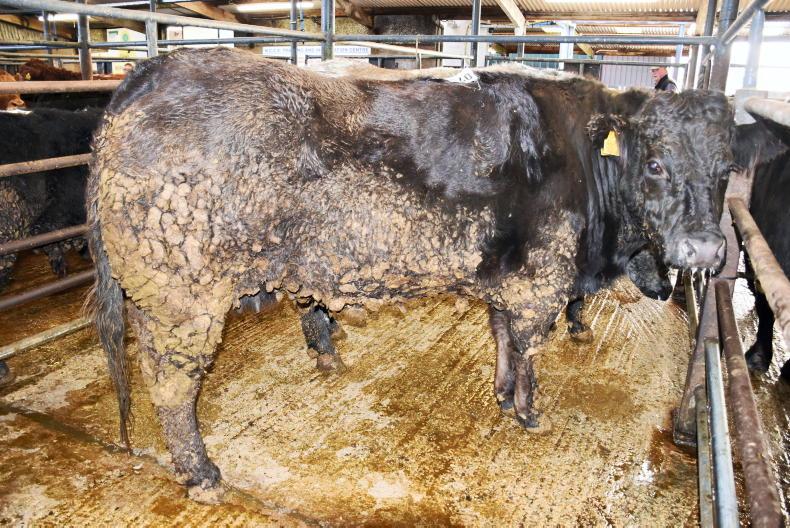

SHARING OPTIONS